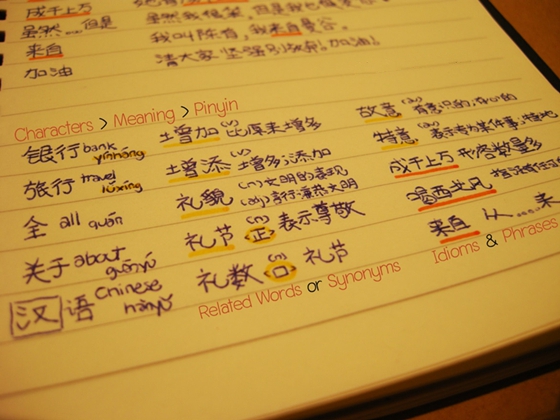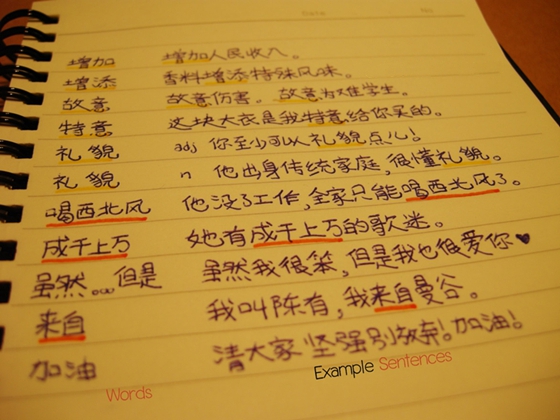
From this article, you will learn how to manage new vocabulary in your notebook!
1. Words Zone
As its name implies, you will gather and collect your new words down here, and this is the way that you will organize them.

A. Character Section
– Make sure that the new vocabulary that you’re going to take note of is correct. Quite easy, ha!
B. Pinyin Section
– Kick pinyin to the curb! Make it small as much as possible, so you will not see them so easily. For me, I always put it behind the meaning, and this will help you to not rely on it. So you won’t see them!
– Please check if the vocabulary is a multi-sound character. Some words when they are used as nouns, they will be pronounced one way, but when used as adjectives, it will be in another way! For example, “空”, if you mean “vacancy/space (n),” you have to say kòng, but if you mean “empty (adj),” you have to say “kōng”!
C. Meaning Section
– What you have to decide is: does the word has related words, or synonyms? If the answer is yes, there will be 4 points that you need to know more about, and yes, we have to note it down, for sure!
i. Is the vocabulary a specific word or an abstract word? Some words are only used for specific, and the related word will be used for specific. For example, 增加zēng jiā and 增添zēng tiān; they both mean “increase” but 增加 is used with countable things (specific), such as numbers, and 增添 is used with uncountable things (abstract), such as feelings.
ii. For some synonyms, you must know the occasion that it is used too. Is it able to be used in every occasion? Is it slang or spoken Mandarin? Official word? Literal, written, or classic word? Try to know and you will use it right! When I take notes, I will write the word that stands for these occasions, such as 正 (for 正式 official), 古 (for 古文 Classical), 口 (for 口语 Spoken), etc.
iii. For some words, we need to know that what does the meaning exactly place emphasis on, such as 故意gù yì and 特意tè yì; you can see that it means deliberately, but 特意 emphasizes doing good things, while 故意 emphasizes doing bad things.
iv. Is it a noun, verb, adjective, or adverb? As every word doesn’t have a pattern that we can see like in English, you need to know how it is used. Some vocabularies can be used in many forms, but some cannot. Example: 礼貌 lǐ mào and 礼节 lǐ jié, they both mean “Courtesy (n)” but only 礼貌can be used as an adjective and mean “be polite.”
2. Example Zone
This is the zone where you will write down the vocabulary, phrase, or sentence structure that you need some example of, so you can review and always understand!

A. Arranging
– Bring the new vocabulary that you need some examples of to the front, and don’t forget to hi-light them when you write in the sentence so you can find them easily.
B. Writing the example
– The best example is the example that you create by yourself, but don’t forget to ask your teacher if it’s not weird; this will help you remember it better, and help you practice using those vocabularies.
3. Top of the Tops Secret
Use less mother language in your notebook! Try to use Mandarin to take notes as much as possible. That’s how we can make more progress, and also have more chances to use it!



 闽公网安备 35020302035673号
闽公网安备 35020302035673号
0 responses on "Tips for taking notes while learning Chinese"